|
|
|
Sort Order |
|
|
|
Items / Page
|
|
|
|
|
|
|
| Srl | Item |
| 1 |
ID:
094079
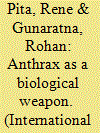

|
|
|
|
|
| Publication |
2010.
|
| Summary/Abstract |
On 5 October 2001, not even a month after the terrorist attacks of 11 September 2001 (9/11), a person died in Boca Raton, Florida, of inhalational anthrax. The low incidence of this disease (only eighteen occupational exposure cases were recorded in the United States during the twentieth century);1 the concern generated after 9/11 regarding possible al-Qaeda attacks using chemical, biological, radiological, or nuclear (CBRN) weapons; and the fact that the etiological agent of this illness is the biological weapon (BW) par excellence, triggered alarms when the cause of this death was made public. Traces of the biological agent were detected a few days later in American Media, Inc. (AMI) facilities, where the deceased worked. Two envelopes, postmarked 18 September, addressed to an NBC reporter and to the editor of the New York Post, both with threatening messages and indicating that they contained anthrax, were retrieved. For a series of reasons, the logical thing to do at that time was to relate these mailings to al-Qaeda. Among those reasons were the proximity in time of the postal mailings with the 9/11 terrorist attacks; the messages included in the envelopes had 9/11 allusions and phrases such as "Death to America," "Death to Israel," and "Allah is great"; and the suspected interest of the 9/11 suicide terrorists in agricultural aircraft to disseminate chemical or biological agents. This is when what is colloquially known as the "Amerithrax"-the name that the Federal Bureau of Investigation (FBI) gave to the criminal investigation-investigation began.
|
|
|
|
|
|
|
|
|
|
|
|
|
|
|
|
| 2 |
ID:
182961
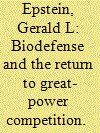

|
|
|
|
|
| Summary/Abstract |
The 2017 US National Security Strategy asserts that, “after being dismissed as a phenomenon of an earlier century, great power competition returned,” pointing to actions that Russia and China have taken to reassert their influence and attempt to change the international order. Such a shift has implications for biodefense. It suggests an increased likelihood of the development and potential use of biological weapons by states, which had been downplayed by those who have been more concerned about non-state biological-weapons programs. State program access to expertise, facilities, and resources implies a greater level of technological sophistication than would typically be credited to non-state actors, influencing the requirements for national biodefense programs to detect, characterize, respond, to, and attribute a biological attack. States also could have missions for biological weapons that differ from those intended by terrorists.
|
|
|
|
|
|
|
|
|
|
|
|
|
|
|
|
| 3 |
ID:
101553
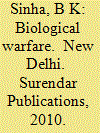

|
|
|
|
|
| Publication |
New Delhi, Surendar Publications, 2010.
|
| Description |
246p.
|
| Standard Number |
9789380014494, hbk
|
|
|
|
|
|
|
|
|
|
|
|
Copies: C:1/I:0,R:0,Q:0
Circulation
| Accession# | Call# | Current Location | Status | Policy | Location |
| 055599 | 358.38/SIN 055599 | Main | On Shelf | General | |
|
|
|
|
| 4 |
ID:
071437


|
|
|
|
|
| Publication |
Geneva, Bio Weapons Prevention Project, 2004.
|
| Description |
iv, 175p.
|
|
|
|
|
|
|
|
|
|
|
|
Copies: C:1/I:0,R:0,Q:0
Circulation
| Accession# | Call# | Current Location | Status | Policy | Location |
| 051207 | 358.38/BIO 051207 | Main | On Shelf | General | |
|
|
|
|
| 5 |
ID:
182955
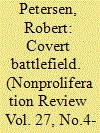

|
|
|
|
|
| Summary/Abstract |
During World War II, the Polish resistance movement used chemical and biological weapons (CBW) against the Third Reich. The use of CBW against the Third Reich most likely originated in a secret Polish biological-weapons program, which existed in the 1930s and went underground after the September 1939 German invasion. Between 1940 and 1942, a unit of the Polish resistance movement named WKZO (Wielkopolskie Kierownictwo Związku Odwetu—the Greater Poland Leadership of the Union of Retaliation) conducted CBW sabotage in the German-annexed area Reichsgau Wartheland and its main city Posen (today’s Poznań). By investigating the use of CBW by the WKZO until its destruction in 1942, it is possible to demonstrate how these weapons were made and used. The article also describes the German reaction, including what defensive measures the German high command took to meet the threat of CBW.
|
|
|
|
|
|
|
|
|
|
|
|
|
|
|
|
| 6 |
ID:
090333
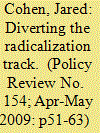

|
|
|
| 7 |
ID:
101546
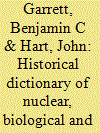

|
|
|
|
|
| Publication |
New Delhi, Pentagon Press, 2010.
|
| Description |
xxxvi, 259p.
|
| Standard Number |
9780810854840, hbk
|
|
|
|
|
|
|
|
|
|
|
|
Copies: C:1/I:0,R:1,Q:0
Circulation
| Accession# | Call# | Current Location | Status | Policy | Location |
| 055595 | 358.303/GAR 055595 | Main | On Shelf | Reference books | |
|
|
|
|
| 8 |
ID:
169463
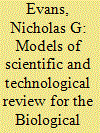

|
|
|
|
|
| Summary/Abstract |
Science and technology (S&T) review is key to anticipating developments in the life sciences that may benefit or run contrary to the aims of the 1972 Biological and Toxin Weapons Convention. It serves as a mechanism for both preparing against novel biological threats and identifying the best opportunities for developing and sharing the life sciences to the fullest extent. In the age of rapidly advancing biotechnology, S&T review needs to be wide ranging, involve a diverse set of inputs, and be transparent about its methods and data. This viewpoint considers four models of S&T review and their capacity to respond to the challenge of the life sciences: standing advisory boards; ad hoc working groups; peer review; and wikis. It then identifies a hybrid model that is suitably broad, diverse, and transparent.
|
|
|
|
|
|
|
|
|
|
|
|
|
|
|
|
| 9 |
ID:
109782


|
|
|
|
|
| Publication |
2011.
|
| Summary/Abstract |
Since the mid-1990s, academic and policy communities have debated the risk posed by terrorist use of chemical, biological, radiological, or nuclear (CBRN) weapons. Three major schools of thought in the debate have emerged: the optimists, the pessimists, and the pragmatists. Although these three schools of thought draw on the same limited universe of data on CBRN terrorism, they arrive at strikingly different conclusions. Given the highly subjective process of CBRN terrorism risk assessment, this article analyzes the influence of mental shortcuts (called heuristics) and the systemic errors they create (called biases) on the risk assessment process. This article identifies and provides illustrative examples of a range of heuristics and biases that lead to the underestimation of risks, the overestimation of risks and, most importantly, those that degrade the quality of the debate about the level of risk. While these types of biases are commonly seen as affecting the public's perception of risk, such biases can also be found in risk assessments by experts. The article concludes with recommendations for improving the CBRN risk assessment process.
|
|
|
|
|
|
|
|
|
|
|
|
|
|
|
|
| 10 |
ID:
122998


|
|
|
|
|
| Publication |
2013.
|
| Summary/Abstract |
Is it better to publish or restrict potentially dangerous dual-use scientific research? This question sparked international attention in mid 2011 when two researchers separately sought to publish scientific studies that demonstrated that laboratory-derived strains of the highly pathogenic avian influenza H5N1 virus became capable of airborne transmission after a few genetic manipulations. These findings raised fears that the virus could become easily transmissible among mammals and that rogue actors could use the published information to create a biological weapon. In response, some governments sought to restrict or prohibit the publication of such research. Other actors countered that sharing this information was the best way to ensure national and international safety and security. In this article, I examine the competing demands between public health and national security by examining two dual-use research controversies. This article shows that the best solution to dual-use dilemmas in security-sensitive biological research is to promote an international norm of dual-use awareness. This balances the value of transparent scientific research with dual-use research's potential implications to provide the highest degree of security. Promoting a global norm, cognizant of potential consequences, would allow for scientific research to continue while ensuring that security considerations play a vital role in conditioning the scientific conversation. Such an effort need not be directed by governments; indeed, professional societies could and should take the lead in promoting such efforts.
|
|
|
|
|
|
|
|
|
|
|
|
|
|
|
|
| 11 |
ID:
006504
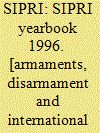

|
|
|
|
|
| Publication |
Oxford, Oxford University Press, 1996.
|
| Description |
xxxviii, 830p.hbk
|
| Series |
SIPRI Yearbook 1996
|
| Standard Number |
0198292093
|
|
|
|
|
|
|
|
|
|
|
|
Copies: C:2/I:0,R:0,Q:0
Circulation
| Accession# | Call# | Current Location | Status | Policy | Location |
| 038232 | 327.17405/SIP 038232 | Main | On Shelf | General | |
| 038362 | 327.17405/SIP 038362 | Main | On Shelf | General | |
|
|
|
|
| 12 |
ID:
061725


|
|
|
|
|
| Publication |
London, Sheed and Ward, 1969.
|
| Description |
420p.
|
| Standard Number |
0853451435
|
|
|
|
|
|
|
|
|
|
|
|
Copies: C:1/I:0,R:0,Q:0
Circulation
| Accession# | Call# | Current Location | Status | Policy | Location |
| 004256 | 358.3/COO 004256 | Main | On Shelf | General | |
|
|
|
|
| 13 |
ID:
182972


|
|
|
|
|
| Summary/Abstract |
This article explores emerging science and technology advances relevant to the 1972 Biological and Toxin Weapons Convention (BWC), and existing and needed frameworks for their identification, risk assessment, and evaluation of benefit. Threats from biological weapons continue to be a major concern as state and non-state actors have developed, used, or expressed interest in these types of weapons. International nonproliferation instruments and related efforts in health security, specifically the 2005 International Health Regulations and the 2014 Global Health Security Agenda, recognize deliberate biological incidents as one of three threats to address (the others being natural and accidental biological events). To date, these instruments and their subsequent regional and national-level implementation efforts focus primarily on pathogens and toxins as biological threat agents. Unlike the other instruments, the BWC focuses on preventing the diversion of peaceful and prophylactic uses of biology to the development, production, stockpiling, or dissemination and delivery of biological weapons. Accordingly, the BWC recognizes the importance of scientific and technological advances in enabling different actors to develop or disseminate biological agents, altering the risk profile of deliberate biological threats. To identify and discuss advances that may affect implementation of the BWC, the US National Academy of Sciences and the BWC Implementation Support Unit conducted or sponsored several activities to explore science and technologies that may be most relevant to the BWC. However, the biotechnology landscape continues to change drastically, expanding the focus of security risks beyond pathogens and toxins to include other biological data and materials, such as synthetic organisms. Factors promoting the development of biotechnology capabilities include new funders and funding models, practitioners from other disciplines leveraging the tools of biology, new nations investing in the biological sciences, and research leveraging advances in engineering, computer, data, materials, physical, and chemical sciences. These advances may reveal new capabilities that significantly alter biological nonproliferation efforts, including both new security threats and benefits to society.
|
|
|
|
|
|
|
|
|
|
|
|
|
|
|
|
|
|
|
|
|